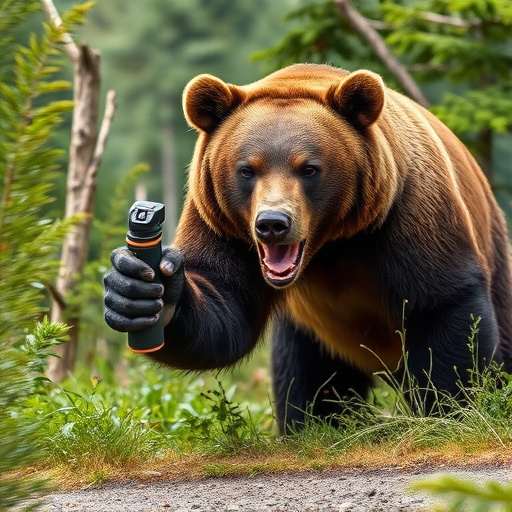Understanding bear behavior is key for safety in bear country. Black bears generally avoid humans but can react aggressively if surprised, while brown bears are more defensive and predatory. Bear spray, an effective deterrent when used correctly, has a variable success rate based on factors like proximity and wind direction. Research emphasizes that bear spray should complement other protective measures such as noise-making, visual deterrents, and physical barriers to ensure comprehensive safety in areas with aggressive bears. Proper usage techniques and following local guidelines are crucial for maximizing the effectiveness of bear spray while minimizing risks during encounters.
In areas where aggressive bears roam, understanding their behavior and implementing effective protection measures is crucial. This article delves into the intricate world of bear aggression and explores various strategies for outdoor safety. We examine the efficacy of bear spray through comprehensive research, offering insights into its performance.
Beyond spray, alternative measures are discussed, providing a multifaceted approach to coexisting with these majestic creatures. From practical tips on wilderness navigation to understanding their habitat, readers will gain valuable knowledge on navigating in bear country.
- Understanding Bear Behavior and Their Aggression
- Bear Spray: A Closer Look at Its Efficacy in Research
- Alternative Measures for Outdoor Safety Beyond Bear Spray
- Practical Tips for Coexisting with Bears in the Wilderness
Understanding Bear Behavior and Their Aggression
Understanding bear behavior is a critical step in ensuring your safety while outdoors in bear country. Bears, particularly aggressive ones, are often driven by food-seeking behaviors and protecting their cubs. Research shows that black bears typically avoid humans, but when they feel threatened or surprised, they may react aggressively. Brown (grizzly) bears have a more complex behavior pattern; they can be defensive if they perceive a threat to their territory or cubs, but they also hunt for food, which can bring them into contact with humans.
Bear spray, an essential tool in bear country, has been extensively researched for its effectiveness against aggressive bears. Studies indicate that when used correctly, bear spray can deter and incapacitate bears, providing valuable time to escape or seek refuge. However, the success of bear spray depends on various factors, including the proximity of the bear, wind direction, and the user’s ability to apply it effectively. It’s important to note that while bear spray is a game-changer in many situations, it should be one of several layers of protection when venturing into bear habitat.
Bear Spray: A Closer Look at Its Efficacy in Research
Bear spray has long been touted as a crucial tool for outdoor enthusiasts and individuals living in bear country to protect themselves against aggressive bears. But how effective is it, really? The efficacy of bear spray has been a topic of interest in research circles, with various studies exploring its impact on deterring bear attacks.
Recent research provides some intriguing insights. Multiple studies have shown that bear spray can be highly effective when used correctly. When bears are startled or feel threatened, the spray’s irritant and capsaicin components can cause them to retreat, giving people valuable time to escape or seek safety. However, the success rate varies based on factors like bear species, distance, wind direction, and the individual’s handling of the spray. Some studies suggest that black bears might be less affected by bear spray compared to grizzly bears, due to their sensitivity differences. Proper usage techniques are also vital; aiming for the bear’s face and eyes can increase the likelihood of a successful deterrence.
Alternative Measures for Outdoor Safety Beyond Bear Spray
While bear spray is a commonly recommended deterrent, there are several alternative measures that can enhance outdoor safety in areas inhabited by aggressive bears. Understanding the effectiveness of these methods is crucial for visitors and residents alike. Research shows that loud noises and sudden movements can startle bears and prompt them to avoid an area. Devices emitting strong, rapid sounds or those mimicking predator calls can be effective deterrents, especially when combined with visual elements like bright flashes or reflective objects.
Another approach involves creating physical barriers. Securing food securely and storing it in bear-resistant containers can significantly reduce the risk of attracting bears. Additionally, installing electric fences around campgrounds or cabins can provide a safe haven. These alternative measures complement existing strategies, offering a multi-faceted approach to outdoor safety that goes beyond reliance on bear spray alone.
Practical Tips for Coexisting with Bears in the Wilderness
When venturing into bear country, understanding how to coexist peacefully with these majestic creatures is crucial for a safe and enjoyable outdoor experience. While encounters can be rare, being prepared and implementing practical tips can significantly reduce risks. One of the most debated topics among outdoor enthusiasts is the effectiveness of bear spray as a deterrent. Extensive research has shown that when used correctly, bear spray can be highly effective in deterring aggressive bears, providing valuable time for escape or retreat.
Key practices include ensuring your spray is certified and always keeping it readily accessible. Prior to any hike, familiarize yourself with local guidelines and bear behavior patterns. Making noise while hiking, especially in dense vegetation, can help ward off bears, as they generally avoid human interaction. Additionally, storing food securely in bear-resistant containers and avoiding unpredictable behaviors like sudden movements or loud voices can reduce the likelihood of an encounter.
In understanding bear behavior and aggression, it’s clear that a multi-faceted approach to outdoor safety is crucial. While bear spray has been widely recommended, research on its effectiveness varies. Alternative measures, such as noise makers and secure food storage, prove valuable in specific situations. Ultimately, coexisting with bears requires a blend of knowledge, preparation, and respect for their natural habits, ensuring safer encounters in the wilderness.
